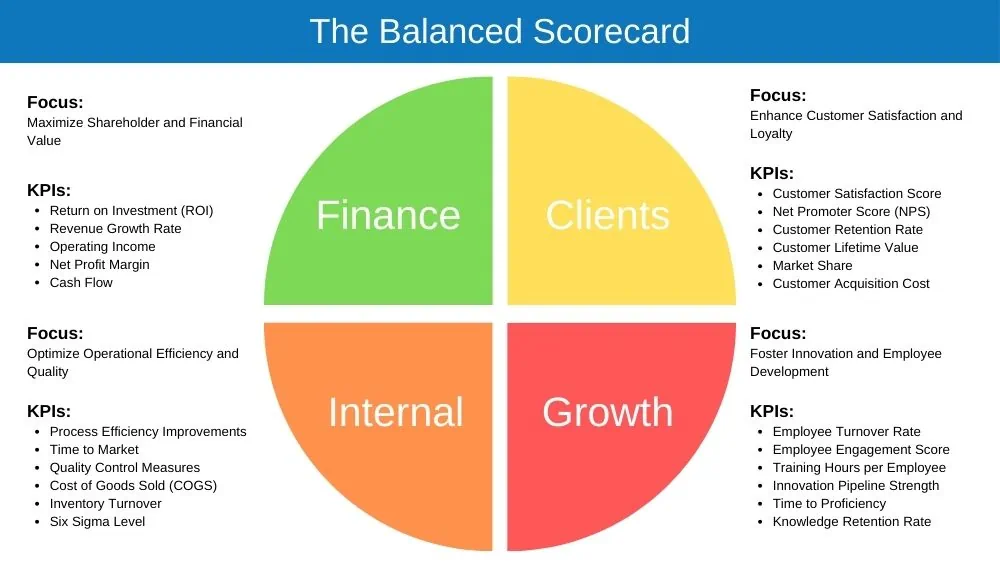When it comes to marketing theories and strategic management, the Balanced Scorecard (BSC) emerges as a revolutionary framework, transcending traditional financial measures to offer a more comprehensive view of organizational performance.
Developed by Robert S. Kaplan and David P. Norton, and first introduced in the Harvard Business Review, the Balanced Scorecard has reshaped how businesses gauge success and align their strategies for long-term sustainability.
It extends beyond mere financial analysis, incorporating multiple perspectives to provide a balanced view. This approach reflects a shift from industrial-age companies, which relied heavily on financial accounting measures, to modern organizations that recognize the value of a broader performance measurement system.

Understanding the Balanced Scorecard Framework
The Balanced Scorecard framework is predicated on the idea that solely relying on traditional financial measures, such as operating income or expenses, offers an incomplete picture of a company’s health and prospects.
To address this, Kaplan and Norton introduced four perspectives that collectively contribute to a strategic management tool, providing a more holistic view of an organization’s strategy and operational efficiency.
Here are the four balanced scorecard perspectives:
Financial Perspective
At its core, the financial perspective continues to play a vital role. It includes traditional financial performance measures like revenue growth, operating expenses, and shareholder value. However, in the Balanced Scorecard system, these financial goals and measures are balanced with other critical performance metrics.
KPIs:
- Return on Investment (ROI)
- Revenue Growth Rate
- Operating Income
- Net Profit Margin
- Earnings Before Interest and Taxes (EBIT)
- Cash Flow
Customer Perspective
This perspective focuses on customer satisfaction and relationships. It emphasizes understanding and improving the aspects that drive customer value, such as product quality, customer service, and brand perception. It’s about measuring how well the organization is delivering on the expectations of its market segments.
KPIs:
- Customer Satisfaction Score
- Net Promoter Score (NPS)
- Customer Retention Rate
- Customer Lifetime Value
- Market Share
- Customer Acquisition Cost
Internal Business Processes
The internal process perspective looks at the operational efficiency and effectiveness of business processes. It encourages continuous improvement and operational excellence in key business units and processes. This perspective helps in identifying and measuring the internal processes that are crucial for achieving the company’s competitive agenda and strategic goals.
KPIs:
- Process Efficiency Improvements
- Time to Market
- Quality Control Measures
- Cost of Goods Sold (COGS)
- Inventory Turnover – Six Sigma Level
Learning and Growth
Often referred to as the “innovation and improvement perspective” or simply “organizational capacity,” this angle covers the human, information, and organizational dimensions.
It involves measuring the company’s ability to innovate, improve, and learn – essentially, to create future value. This encompasses human capital, information capital, and organizational culture.
Together, these four perspectives of the Balanced Scorecard provide a framework not just for what a company measures, but also for what it strives to achieve. It aligns short-term financial measures with long-term strategic goals, ensuring that every part of the business contributes to the overall strategy and constantly improving strategic performance.
In the Balanced Scorecard approach, these different elements are connected through cause-and-effect relationships, creating a strategy map that guides the entire organization towards strategic success.
Managers can view and prepare the balanced scorecard measures each month or quarter.
Developing a Balanced Scorecard: A Step-by-Step Approach
The development of a Balanced Scorecard (BSC) is a strategic undertaking that requires careful planning and a deep understanding of an organization’s goals and capabilities. Here’s a structured approach to creating an effective BSC:
Identifying Strategic Objectives
The first step involves articulating the organization’s strategic objectives. This requires senior executives to understand and define what they aim to achieve in the long term. These objectives should encompass all areas of the business and align with the overall vision and mission.
Setting Key Performance Indicators (KPIs) for Each Perspective
For each of the four perspectives – Financial, Customer, Internal Business Processes, and Learning and Growth – identify specific KPIs that will serve as performance measures.
These KPIs should be quantifiable and relevant to the strategic objectives. For example, under the financial perspective, KPIs could include metrics like net profit margin or return on investment, whereas the customer perspective might focus on customer satisfaction scores or retention rates.
Linking Objectives to Measures and Initiatives
Each strategic objective should be linked to specific measures that indicate progress towards achieving that objective. This involves not just setting KPIs but also identifying the initiatives or actions required to influence these KPIs.
For instance, if a strategic objective is to enhance operational efficiency (an internal process goal), the corresponding measure might be the reduction in turnaround time for a key business process.
Implementing the Balanced Scorecard in a Marketing Context
When applied to marketing, the Balanced Scorecard offers a structured way to align marketing strategies with the broader objectives of the organization. Implementing the BSC in a marketing context involves:
Customizing the Balanced Scorecard for Marketing Strategies:
The BSC framework must be adapted to reflect the unique aspects of the marketing function. This could involve emphasizing metrics related to customer engagement, brand recognition, and market share within the customer perspective.
In the internal processes perspective, focus might be given to the efficiency of marketing campaigns and the effectiveness of sales channels.
Aligning Marketing Goals with Broader Business Objectives:
It is essential that the marketing strategy, as outlined in the balanced scorecard, is in harmony with the company’s overall strategy.
This alignment ensures that marketing efforts contribute directly to the organization’s strategic goals, whether it’s growing the customer base, entering new market segments, or improving the existing customer relationships.
By incorporating these steps, balanced scorecards become a vital tool for marketing leaders, ensuring that their efforts are not only strategically sound but also measurable and aligned with the organization’s long-term goals.
In the next sections, we will explore real-world applications of the BSC and its integration with other marketing theories and tools.
Case Studies: Balanced Scorecard in Action
The Balanced Scorecard has been employed by various organizations across different industries, yielding insightful success stories and key lessons. Let’s explore a few case studies that demonstrate the practical application and impact of the Balanced Scorecard:
- Technology Sector Implementation: A leading technology firm used the Balanced Scorecard to reorient its strategy towards customer-centric innovation. By focusing on the Customer Perspective, they improved customer satisfaction metrics, which led to an increase in market share and, subsequently, better financial performance. Their strategy map highlighted how enhancing customer relationships and investing in learning and growth directly contributed to achieving their financial goals.
- Retail Industry Success: In the competitive retail sector, a multinational company implemented the Balanced Scorecard to balance its operational efficiency with customer service excellence. The Internal Business Processes perspective helped them streamline their distribution processes, while the Customer Perspective guided efforts to enhance the in-store experience. This dual focus supported their strategic goal of becoming the market leader in customer service, translating into improved financial results and customer loyalty.
- Healthcare Sector Transformation: A healthcare organization applied the Balanced Scorecard to align its services with patient care quality and operational efficiency. By prioritizing the Learning and Growth perspective, they invested in employee training and development, leading to more effective internal processes and higher patient satisfaction. This holistic approach not only improved their financial viability but also established them as a top provider of quality healthcare services.
Challenges and Limitations of the Balanced Scorecard
While the Balanced Scorecard is a powerful strategic management tool, it comes with its own set of challenges and limitations:
Complexity in Implementation
One of the primary challenges lies in its implementation. Developing a Balanced Scorecard can be a complex process, requiring a deep understanding of the organization’s strategy and the ability to translate it into measurable KPIs across various perspectives.
Potential for Overemphasis on Measurement
There is a risk of focusing too much on measurement and not enough on strategy. Some organizations may get caught up in tracking KPIs without effectively using this data to drive strategic decision-making and improvements.
Need for Continuous Update
The Balanced Scorecard is not a set-and-forget tool. It requires continuous refinement and updating to remain relevant, especially in rapidly changing business environments. Organizations must be willing to adapt their scorecards in response to internal changes and external market dynamics.
Despite these challenges, the Balanced Scorecard remains a valuable framework for organizations seeking a balanced approach to strategic management and performance measurement.
It encourages a broader view of organizational performance, beyond just financial metrics, encompassing customer satisfaction, internal processes efficiency, and the growth and learning of the workforce.
Integrating the Balanced Scorecard with Other Marketing Theories
The Balanced Scorecard, while effective on its own, can achieve greater strategic depth when integrated with other marketing theories and tools. This synergy enhances its ability to provide a comprehensive view of an organization’s strategy and performance.
Synergies with SWOT Analysis and Ansoff Matrix
Integrating the Balanced Scorecard with a SWOT analysis (Strengths, Weaknesses, Opportunities, Threats) allows organizations to align their internal strengths and weaknesses with external opportunities and threats.
Similarly, combining it with the Ansoff Matrix can help in strategically planning for market penetration, market development, product development, and diversification.
Combining Qualitative and Quantitative approaches
The Balanced Scorecard is inherently quantitative, focusing on key performance indicators and metrics. However, it gains a qualitative dimension when combined with tools that assess customer relationships, brand value, and employee engagement.
This combination ensures that strategic planning is both data-driven and aligned with the softer aspects of business, such as customer satisfaction and employee development.
Advanced Insights in Balanced Scorecard Usage
Delving deeper into the Balanced Scorecard, there are advanced techniques and insights that can enhance its effectiveness in strategic planning and performance management:
Strategic Mapping and Scenario Planning
The use of strategy maps in the Balanced Scorecard framework helps visualize the cause-and-effect relationships between different strategic objectives across the four perspectives.
This tool aids in illustrating how improvements in one area, such as internal processes or learning and growth, can positively impact other areas like customer satisfaction and financial performance. Additionally, incorporating scenario planning can help organizations anticipate potential future challenges and adapt their strategies accordingly.
Evolving the Balanced Scorecard for Digital Marketing
In the realm of digital marketing, the Balanced Scorecard can be adapted to include metrics specific to digital platforms, such as online engagement rates, digital campaign ROI, and e-commerce conversion rates.
This adaptation ensures that the Balanced Scorecard remains relevant and effective in guiding digital marketing strategies, reflecting the ever-increasing importance of online platforms in business.
The Future of the Balanced Scorecard in Strategic Planning
As we look towards the future, the Balanced Scorecard is set to remain an integral part of strategic planning, albeit with continuous adaptations to suit the changing business landscape.
- Emerging Trends and Adaptations: The future of the Balanced Scorecard lies in its ability to integrate emerging trends and technologies. This includes adapting to advancements in AI and machine learning for predictive analytics, incorporating real-time data for more agile decision-making, and aligning with sustainability goals, reflecting an increasing focus on environmental and social governance (ESG) criteria.
- Staying Relevant in a Dynamic Business Environment: To maintain its relevance, the Balanced Scorecard must evolve in line with the rapidly changing business environment. This involves continuously updating the framework to include new and relevant metrics, adapting to shifts in market dynamics, and integrating innovative management practices. By doing so, it can continue to provide comprehensive insights into organizational performance and guide businesses towards strategic success in an increasingly complex and competitive landscape.
Conclusion
The Balanced Scorecard (BSC) stands as a testament to the evolution of strategic planning and performance management in the modern business era.
Developed as a response to the inadequacies of traditional financial metrics, it has grown into a comprehensive framework that balances various aspects of organizational performance – financial results, customer satisfaction, internal processes, and learning and growth.
This multifaceted approach ensures that businesses do not just chase short-term financial gains but also invest in areas crucial for long-term sustainability and growth.
As businesses navigate an increasingly complex and dynamic environment, the Balanced Scorecard remains more relevant than ever. Its flexibility and adaptability make it an invaluable tool for integrating emerging trends, from digital marketing metrics to ESG criteria.
The Balanced Scorecard’s ability to align an organization’s strategic goals with operational actions and measure performance across various dimensions ensures a holistic approach to achieving business success.
In its essence, the Balanced Scorecard is not just a measurement system but a management system that helps organizations translate their vision and strategy into action. It provides a roadmap for organizations to follow, ensuring that they remain focused on their strategic objectives while adapting to changes in the business landscape.
As we move forward, the Balanced Scorecard is likely to continue evolving, integrating new methodologies and technologies. However, its core principle of maintaining a balanced perspective on organizational performance will undoubtedly remain a guiding light for businesses striving for strategic success in an ever-changing world.








0 Comments